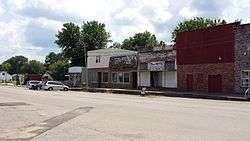Ola, Arkansas
| Ola, Arkansas | |
|---|---|
| City | |
|
Looking east down Highway 10 in Ola | |
 Location in Yell County and the state of Arkansas | |
| Coordinates: 35°1′54″N 93°13′17″W / 35.03167°N 93.22139°WCoordinates: 35°1′54″N 93°13′17″W / 35.03167°N 93.22139°W | |
| Country | United States |
| State | Arkansas |
| County | Yell |
| Area | |
| • Total | 2 sq mi (5.1 km2) |
| • Land | 1.9 sq mi (4.8 km2) |
| • Water | 0.1 sq mi (0.3 km2) |
| Elevation | 361 ft (110 m) |
| Population (2000) | |
| • Total | 1,204 |
| • Density | 602/sq mi (236.1/km2) |
| Time zone | Central (CST) (UTC-6) |
| • Summer (DST) | CDT (UTC-5) |
| ZIP code | 72853 |
| Area code(s) | 479 |
| FIPS code | 05-51560 |
| GNIS feature ID | 0081884 |
Ola is a city in Yell County, Arkansas, United States. The population was 1,204 at the 2000 census. It is part of the Russellville Micropolitan Statistical Area.
Geography
Ola is located at 35°1′54″N 93°13′17″W / 35.03167°N 93.22139°W (35.031748, -93.221309).[1]
According to the United States Census Bureau, the city has a total area of 2.0 square miles (5.2 km2), of which 1.9 square miles (4.9 km2) is land and 0.1 square miles (0.26 km2) (6.53%) is water.
Demographics
| Historical population | |||
|---|---|---|---|
| Census | Pop. | %± | |
| 1910 | 516 | — | |
| 1920 | 655 | 26.9% | |
| 1930 | 648 | −1.1% | |
| 1940 | 839 | 29.5% | |
| 1950 | 880 | 4.9% | |
| 1960 | 805 | −8.5% | |
| 1970 | 1,029 | 27.8% | |
| 1980 | 1,121 | 8.9% | |
| 1990 | 1,090 | −2.8% | |
| 2000 | 1,204 | 10.5% | |
| 2010 | 1,281 | 6.4% | |
| Est. 2015 | 1,250 | [2] | −2.4% |
As of the census[4] of 2000, there were 1,204 people, 464 households, and 283 families residing in the city. The population density was 648.4 people per square mile (249.9/km²). There were 556 housing units at an average density of 299.4 per square mile (115.4/km²). The racial makeup of the city was 83.89% White, 0.42% Black or African American, 0.25% Native American, 0.25% Asian, 0.17% Pacific Islander, 12.96% from other races, and 2.08% from two or more races. 16.86% of the population were Hispanic or Latino of any race.
There were 464 households out of which 33.6% had children under the age of 18 living with them, 41.6% were married couples living together, 14.2% had a female householder with no husband present, and 39.0% were non-families. 34.5% of all households were made up of individuals and 17.9% had someone living alone who was 65 years of age or older. The average household size was 2.44 and the average family size was 3.18.
In the city the population was spread out with 28.3% under the age of 18, 8.3% from 18 to 24, 26.5% from 25 to 44, 18.9% from 45 to 64, and 18.0% who were 65 years of age or older. The median age was 36 years. For every 100 females there were 88.1 males. For every 100 females age 18 and over, there were 84.0 males.
The median income for a household in the city was $19,375, and the median income for a family was $24,125. Males had a median income of $21,250 versus $16,100 for females. The per capita income for the city was $10,117. About 20.1% of families and 27.2% of the population were below the poverty line, including 36.9% of those under age 18 and 29.9% of those age 65 or over.
Education
Public education is administered by the Two Rivers School District, which supports :
- Two Rivers High School—Serves students in grades 7–12.
- Two Rivers Elementary School—Serves students in Kindergarten through 6th grade.
Two Rivers School District former in a merger of the school districts that formed around the former Ola High School and Plainview-Rover High School to form the Two Rivers High School.
Some portions of Ola are supported by the Danville School District, which leads to graduation from Danville High School.
Climate
The climate in this area is characterized by hot, humid summers and generally mild to cool winters. According to the Köppen Climate Classification system, Ola has a humid subtropical climate, abbreviated "Cfa" on climate maps.[5]
Notable person
- Babe Ellison, Major League Baseball player, member of Pacific Coast League Hall of Fame
References
- ↑ "US Gazetteer files: 2010, 2000, and 1990". United States Census Bureau. 2011-02-12. Retrieved 2011-04-23.
- ↑ "Annual Estimates of the Resident Population for Incorporated Places: April 1, 2010 to July 1, 2015". Retrieved July 2, 2016.
- ↑ "Census of Population and Housing". Census.gov. Retrieved June 4, 2015.
- ↑ "American FactFinder". United States Census Bureau. Retrieved 2008-01-31.
- ↑ Climate Summary for Ola, Arkansas

